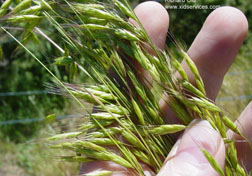This page has been archived and is being provided for reference purposes only. The page is no longer being updated, and therefore, links on the page may be invalid.
|
|
|
|
A New Way to Use Herbicides: To Sterilize, Not Kill Weeds
By Don Comis
May 5, 2010
Using herbicides to sterilize rather than to kill weedy grasses might be a more economical and environmentally sound weed control strategy, according to a study by Agricultural Research Service (ARS) scientists and a cooperator.
Rangeland ecologist Matt Rinella at the ARS Fort Keogh Livestock and Range Research Laboratory in Miles City, Mont., conducted the study with colleagues at Miles City and Robert Masters with Dow AgroSciences LLC, in Indianapolis, Ind.
Exotic annual grasses such as Japanese brome, cheatgrass and medusahead are harming millions of acres of grassland in the western United States. Currently, the herbicides used to control these invasive grasses also sometimes damage desirable perennial grasses.
In contrast, when used properly, growth regulators typically do not greatly harm desirable perennial grasses. Growth regulator herbicides are used to control broadleaf weeds in wheat and other crop grasses, as well as on rangelands. Rinella and his colleagues knew that when dicamba and other growth regulator herbicides were applied to cereal crops late in their growth stage, just before seed formation, the plants produced far fewer seeds.
The scientists decided to see if these herbicides had the same harmful late-stage application effects on the invasive weed Japanese brome. In greenhouse experiments, they tested dicamba (Banvel/Clarity), 2,4-D, and picloram (Tordon) at typically used rates. They found that picloram reduced seed production nearly 100 percent when applied at the late growth stage of the weed. Dicamba was slightly less effective, but still nearly eliminated all seed production, while 2,4-D was much less effective.
Since annual grass seeds only survive in soil a year or two, it should only take one to three years of herbicide treatment at the right growth stage to greatly reduce the soil seed bank of annual weedy grasses without harming perennial grasses.
Rinella has recently finished field tests that support the greenhouse experiment results. He also tested the herbicide aminopyralid (Milestone) and found it was as effective as picloram. Next he will test much lower doses of the herbicides in an attempt to lower costs and reduce non-target damage to broadleaf plants.
The research was published in the journal Invasive Plant Science and Management.
ARS is the principal intramural scientific research agency of the U.S. Department of Agriculture (USDA). This research supports the USDA priority of promoting international food security.

